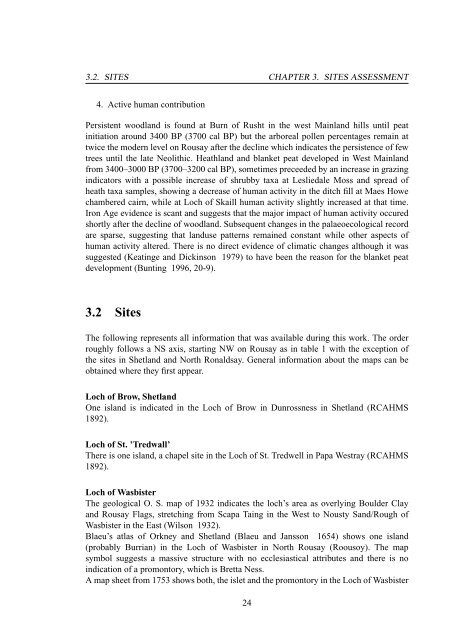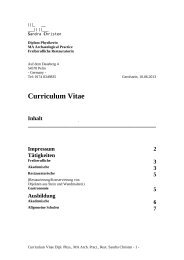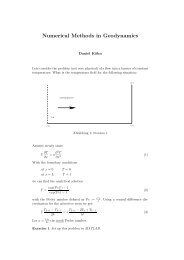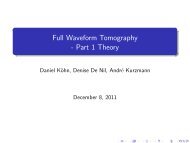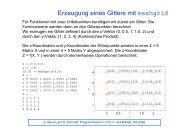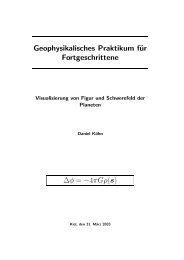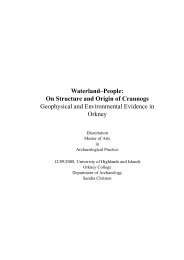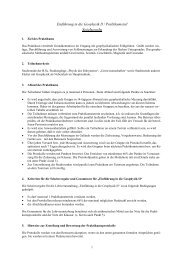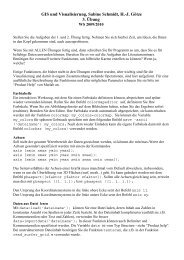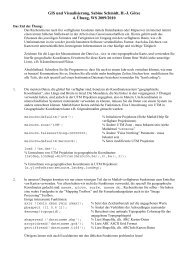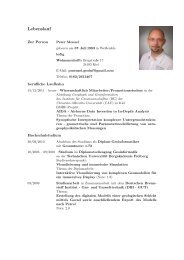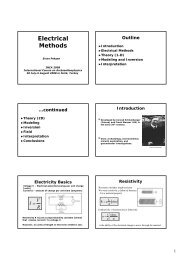Waterland–People: On Structure and Origin of Crannogs ...
Waterland–People: On Structure and Origin of Crannogs ...
Waterland–People: On Structure and Origin of Crannogs ...
Create successful ePaper yourself
Turn your PDF publications into a flip-book with our unique Google optimized e-Paper software.
3.2. SITES CHAPTER 3. SITES ASSESSMENT<br />
4. Active human contribution<br />
Persistent woodl<strong>and</strong> is found at Burn <strong>of</strong> Rusht in the west Mainl<strong>and</strong> hills until peat<br />
initiation around 3400 BP (3700 cal BP) but the arboreal pollen percentages remain at<br />
twice the modern level on Rousay after the decline which indicates the persistence <strong>of</strong> few<br />
trees until the late Neolithic. Heathl<strong>and</strong> <strong>and</strong> blanket peat developed in West Mainl<strong>and</strong><br />
from 3400–3000 BP (3700–3200 cal BP), sometimes preceeded by an increase in grazing<br />
indicators with a possible increase <strong>of</strong> shrubby taxa at Lesliedale Moss <strong>and</strong> spread <strong>of</strong><br />
heath taxa samples, showing a decrease <strong>of</strong> human activity in the ditch fill at Maes Howe<br />
chambered cairn, while at Loch <strong>of</strong> Skaill human activity slightly increased at that time.<br />
Iron Age evidence is scant <strong>and</strong> suggests that the major impact <strong>of</strong> human activity occured<br />
shortly after the decline <strong>of</strong> woodl<strong>and</strong>. Subsequent changes in the palaeoecological record<br />
are sparse, suggesting that l<strong>and</strong>use patterns remained constant while other aspects <strong>of</strong><br />
human activity altered. There is no direct evidence <strong>of</strong> climatic changes although it was<br />
suggested (Keatinge <strong>and</strong> Dickinson 1979) to have been the reason for the blanket peat<br />
development (Bunting 1996, 20-9).<br />
3.2 Sites<br />
The following represents all information that was available during this work. The order<br />
roughly follows a NS axis, starting NW on Rousay as in table 1 with the exception <strong>of</strong><br />
the sites in Shetl<strong>and</strong> <strong>and</strong> North Ronaldsay. General information about the maps can be<br />
obtained where they first appear.<br />
Loch <strong>of</strong> Brow, Shetl<strong>and</strong><br />
<strong>On</strong>e isl<strong>and</strong> is indicated in the Loch <strong>of</strong> Brow in Dunrossness in Shetl<strong>and</strong> (RCAHMS<br />
1892).<br />
Loch <strong>of</strong> St. ’Tredwall’<br />
There is one isl<strong>and</strong>, a chapel site in the Loch <strong>of</strong> St. Tredwell in Papa Westray (RCAHMS<br />
1892).<br />
Loch <strong>of</strong> Wasbister<br />
The geological O. S. map <strong>of</strong> 1932 indicates the loch’s area as overlying Boulder Clay<br />
<strong>and</strong> Rousay Flags, stretching from Scapa Taing in the West to Nousty S<strong>and</strong>/Rough <strong>of</strong><br />
Wasbister in the East (Wilson 1932).<br />
Blaeu’s atlas <strong>of</strong> Orkney <strong>and</strong> Shetl<strong>and</strong> (Blaeu <strong>and</strong> Jansson 1654) shows one isl<strong>and</strong><br />
(probably Burrian) in the Loch <strong>of</strong> Wasbister in North Rousay (Roousoy). The map<br />
symbol suggests a massive structure with no ecclesiastical attributes <strong>and</strong> there is no<br />
indication <strong>of</strong> a promontory, which is Bretta Ness.<br />
A map sheet from 1753 shows both, the islet <strong>and</strong> the promontory in the Loch <strong>of</strong> Wasbister<br />
24


